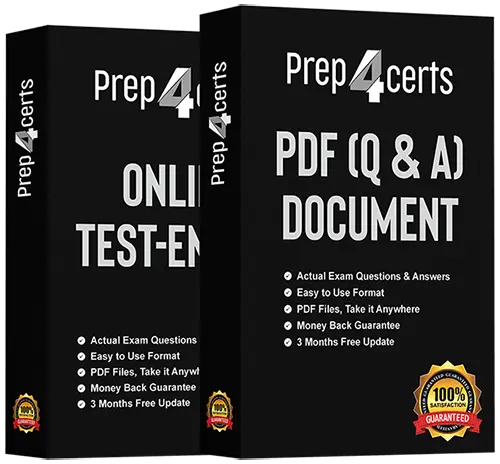
| Exam Code | Development-Lifecycle-and-Deployment-Architect |
| Exam Name | Salesforce Certified Development Lifecycle and Deployment Architect (SU24) |
| Questions | 225 Questions Answers With Explanation |
| Update Date | November 08,2024 |
| Price |
Was : |
Are you ready to take your career to the next level with Salesforce Certified Development Lifecycle and Deployment Architect (SU24)? At Prep4Certs, we're dedicated to helping you achieve your goals by providing high-quality Development-Lifecycle-and-Deployment-Architect Dumps and resources for a wide range of certification exams.
At Prep4Certs, we're committed to your success in the Salesforce Development-Lifecycle-and-Deployment-Architect exam. Our comprehensive study materials and resources are designed to equip you with the knowledge and skills needed to ace the exam with confidence:
Start Your Certification Journey Today
Whether you're looking to advance your career, expand your skill set, or pursue new opportunities, Prep4Certs is here to support you on your certification journey. Explore our comprehensive study materials, take your exam preparation to the next level, and unlock new possibilities for professional growth and success.
Ready to achieve your certification goals? Begin your journey with Prep4Certs today!
In Architect has been working on a large project for the past 6 months. This project must be live by the end of the current month. Which two planning techniques should the Architect use to ensure all metadata changes deploy smoothly and on time? Choose 2 answers
A. Ensure all code that is being deployed is checked into source control
B. Validate the final deployment package against production prior to go-live
C. Create a new sandbox and perform a test deployment to that environment
D. Upload a change set from sandbox to production as early as possible
Which two ways should a developer working on a data loading integration that operates between different Salesforce environments insert multiple related records in one call or transaction? Choose 2 answers
A. REST API SObject Tree Request
B. Bulk API 2.0
C. REST API Composite Request
D. Streaming API
Universal Containers (UC) has two subsidiaries which operate independently. UC has made the decision to operate two of separate Salesforce orgs, one for each subsidiary. However, certain functions and processes between the two orgs must be standardized. Which two approaches should UC take to develop customizations once, and make them available in both orgs? Choose 2 answers
A. Develop the functionality in a sandbox and deploy it to both production orgs
B. Set up Salesforce-to-Salesforce to deploy the functionality from one org to the other
C. Create a managed package in a sandbox and deploy it to both production orgs
D. Create a package in a Developer Edition org and deploy it to both production orgs
Universal Containers (UC) has been using Salesforce Sales Cloud for many years following a highly customized, single-org strategy with great success so far. What two reasons can justify a change to a multi-org strategy? Choose 2 answers
A. UC is launching a new line of business with independent processes and adding any new feature to it is too complex.
B. UC wants to use Chatter for collaboration among different business units and stop working in silos.
C. UC follows a unification enterprise architecture operating model by having orgs with the same processes implemented for each business unit.
D. Acquired company that has its own Salesforce org and operates in a different business with its own set of regulatory requirements.
What is a main characteristic of an agile team?
A. The team uses Scrum, Kanban, and Extreme Programming.
B. The team has biweekly sprints to ensure on-time delivery.
C. The team delivers new releases on dates defined in the beginning of the project, following a project plan
D. The team improves and evolves its processes and frequently delivers value to the endusers.
Which two options should be considered when making production changes in a highly regulated and audited environment? Choose 2 answers
A. All changes including hotfixes should be reviewed against security principles.
B. Any production change should have explicit stakeholder approval.
C. No manual steps should be carried out.
D. After deployment, the development team should test and verify functionality in
production.
Universal Containers has a complex deployment coming up. The deployment will include several Apex classes which depend on custom settings that hold important configuration. How should an Architect manage this deployment?
A. Script the deployment of all functionality via the Force.com Migration Tool
B. Manually deploy and populate custom settings in production using a change set
C. Create a custom metadata type and include this in your deployment to production
D. Manually deploy and populate the custom settings in production prior to the Apex Class deployment
Cloud Kicks is switching to Salesforce from a different CRM. They have existing datasets for all standard Salesforce objects. In which optimized order should the architect recommend these objects be loaded?
A. Accounts, Contacts, Leads, Products, Opportunities, Opportunity Line Items
B. Accounts, Contacts. Opportunities, Products, Opportunity Line Items, Leads
C. Leads, Contacts, Accounts, Opportunities, Products, Opportunity Line Items
D. Leads, Accounts, Contacts, Products, Opportunities, Opportunity Line Items
Universal Containers (UC) is implementing a governance framework and has asked the Architect to make recommendations regarding release planning. Which two decisions should the Architect make when planning for releases? Choose 2 answers
A. How to test existing functionality to ensure no regressions are introduced.
B. Whether Salesforce will wait to upgrade the pod until after a UC release is complete.
C. How to roll back to the previous Salesforce release if there are issues.
D. When to test a new UC feature release if there are issues.
What are two advantages of using an Agile Project Management tool? Choose 2 answers
A. Increased visibility into sprint and project status
B. Better relationships with business stakeholders
C. Consolidate project artifacts to a common repository
D. Improve governance with gate steps in development